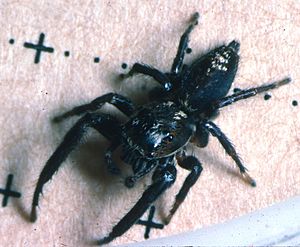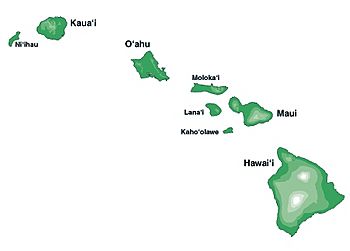Havaika facts for kids
Quick facts for kids Havaika |
|
|---|---|
 |
|
| A male Havaika spider in Hawaii | |
| Scientific classification |
|
| Kingdom: | Animalia |
| Phylum: | Arthropoda |
| Subphylum: | Chelicerata |
| Class: | Arachnida |
| Order: | Araneae |
| Infraorder: | Araneomorphae |
| Family: | Salticidae |
| Subfamily: | Salticinae |
| Genus: | Havaika Prószyński, 2002 |
| Type species | |
| Havaika jamiesoni Prószyński, 2002
|
|
| Species | |
Havaika is a group of tiny spiders known as jumping spiders. They belong to the spider family called Salticidae. These spiders are related to other spider groups like Habronattus and Pellenes. All the known Havaika species were once part of a different spider group called Sandalodes.
These spiders live on the islands of Hawaii and the Marquesas Islands. Scientists believe that the Havaika spiders on Hawaii and the Marquesas Islands arrived there separately. This means they evolved on their own in each place. Some species found in the Marquesas, like H. triangulifera and H. flavipes, are not always included in the Havaika group by some scientists.
Sadly, many Havaika species in Hawaii might already be extinct. This is because their homes have been greatly changed.
Contents
What Do Havaika Spiders Look Like?
Havaika spiders have a body shape similar to other jumping spiders. However, they are special because of how their epigyne looks. The epigyne is a part of the female spider's body.
Their main body part, called the cephalothorax, is dark. It has white hairs that make cool patterns on their face. They also have white and yellow scales on the front of their chelicerae (mouthparts) and around their eyes. These spiders can be very small, less than 2 millimeters long, or grow up to 10 millimeters.
How Havaika Spiders Are Related to Other Spiders
Scientists once placed Havaika spiders in a group called Pelleninae. But now, many scientists don't formally place them in a specific subfamily.
The female parts of Havaika spiders look similar to those of Bianor, Modunda, and Habronattus spiders. However, the inside parts, like the spermathecae, are different. The male parts of Havaika spiders seem more unique and specialized.
How Havaika Spiders Evolved in Hawaii
The ancestors of today's Havaika spiders likely arrived in Hawaii about two million years ago. This was after most of the Hawaiian islands had already formed. Many other spiders had already made Hawaii their home by then.
Usually, when new species form on islands, they follow a "progression rule." This means they colonize islands as they form, creating new species along the way. But Havaika spiders don't seem to follow this rule. Today, Havaika spiders make up about three-quarters of all jumping spider species in Hawaii.
Scientists have found four main groups of Havaika spiders using genetic tests.
- The pubens group: These spiders have yellowish scales on their mouthparts. Males in this group have long palpal tibias (a part of their leg-like feelers). Their main body part is dark brown with two lighter stripes on their back. You can find them on Maui, Moloka'i, Lana'i (which were once one big island), Kaua'i, O'ahu, and Big Island.
- The verecunda group: These spiders look different between males and females. Males have long white hairs on their mouthparts and short palpal tibias. Females have fewer hairs but thick white fur on their clypeus (the area above their mouth). Their black main body part sometimes has a brush of white hairs in the front. They also have two white spots along their back. They live on Moloka'i and Maui (which were once one island), Kaua'i, and O'ahu.
- "Morphotype D": These spiders are mostly dark brown. They have grayish patterns on their abdomen (the back part of their body). They only have a few white scales on the lower edge of their clypeus. They are found on Lana'i.
- The H. cruciata group: These spiders have faces similar to the verecunda group. But they have different features on their bulb (a part of the male's palpal organ). Males have a thin, long embolus (a part used for mating) and a short palpal tibia. They have the same black main body part as the verecunda group. H. cruciata is only found on Big Island. It is likely related to Morphotype D.
- Spiders found on Necker Island and Nihoa (northwest of Kaua'i) did not fit into these four groups.
It is hard to group all the known Havaika species into these specific lineages right now.
When two different Havaika species live on the same island, they are usually very different in size. This suggests that they hunt for different types of food. This helps them avoid competing with each other. It seems that Havaika spiders changed their size soon after arriving in Hawaii. Then, they spread out and formed even more new species. Scientists noticed that the larger of two species living together always belongs to the pubens group. The smaller one always belongs to another group.
Species of Havaika Spiders
Marquesas Islands Group
- Havaika flavipes (Berland, 1933)
- Havaika nigrolineata (Berland, 1933)
- Havaika triangulifera (Berland, 1933)
Hawaii Islands Group
- Havaika albociliata (Simon, 1900) – Found on Lanai Island: Mt. Koele
- Havaika canosa (Simon, 1900) – Found on Maui Island
- Havaika cruciata (Simon, 1900) – Probably found on Hawai'i Island
- Havaika jamiesoni Prószyński, 2002 – Found on Kauai Island
- Havaika pubens (Simon, 1900) – Found on Hawai'i Island
- Havaika navata (Simon, 1900) – Found on Lanai Island
- Havaika senicula (Simon, 1900) – Found on Maui Island
- Havaika valida (Simon, 1900) – Probably found on Oahu Island
- Havaika verecunda (Simon, 1900) – Found on Oahu Island
In 2008, 14 new species from Hawaii were described. Five more unidentified species were also found:
- Havaika arnedoi Prószynski, 2008 – Found on Hawai'i Island
- Havaika beattyi Prószynski, 2008 – Found on Molokai Island
- Havaika berlandi Prószynski, 2008 – Found on Hawai'i Island
- Havaika berryorum Prószynski, 2008 – Found on Hawai'i Island
- Havaika ciliata Prószynski, 2008 – Found on Hawai'i Island
- Havaika gillespieae Prószynski, 2008 – Found on Oahu Island
- Havaika gressitti Prószynski, 2008 – Found on Oahu Island
- Havaika kahiliensis Prószynski, 2008 – Found on Kauai Island
- Havaika kauaiensis Prószynski, 2008 – Found on Kauai Island
- Havaika kraussi Prószynski, 2008 – Found on Maui Island
- Havaika mananensis Prószynski, 2008 – Found on Oahu Island
- Havaika mauiensis Prószynski, 2008 – Found on Maui Island: Hana Forest Reserve
- Havaika oceanica Prószynski, 2008 – Found on Necker Island
- Havaika tantalensis Prószynski, 2008 – Found on Oahu Island


